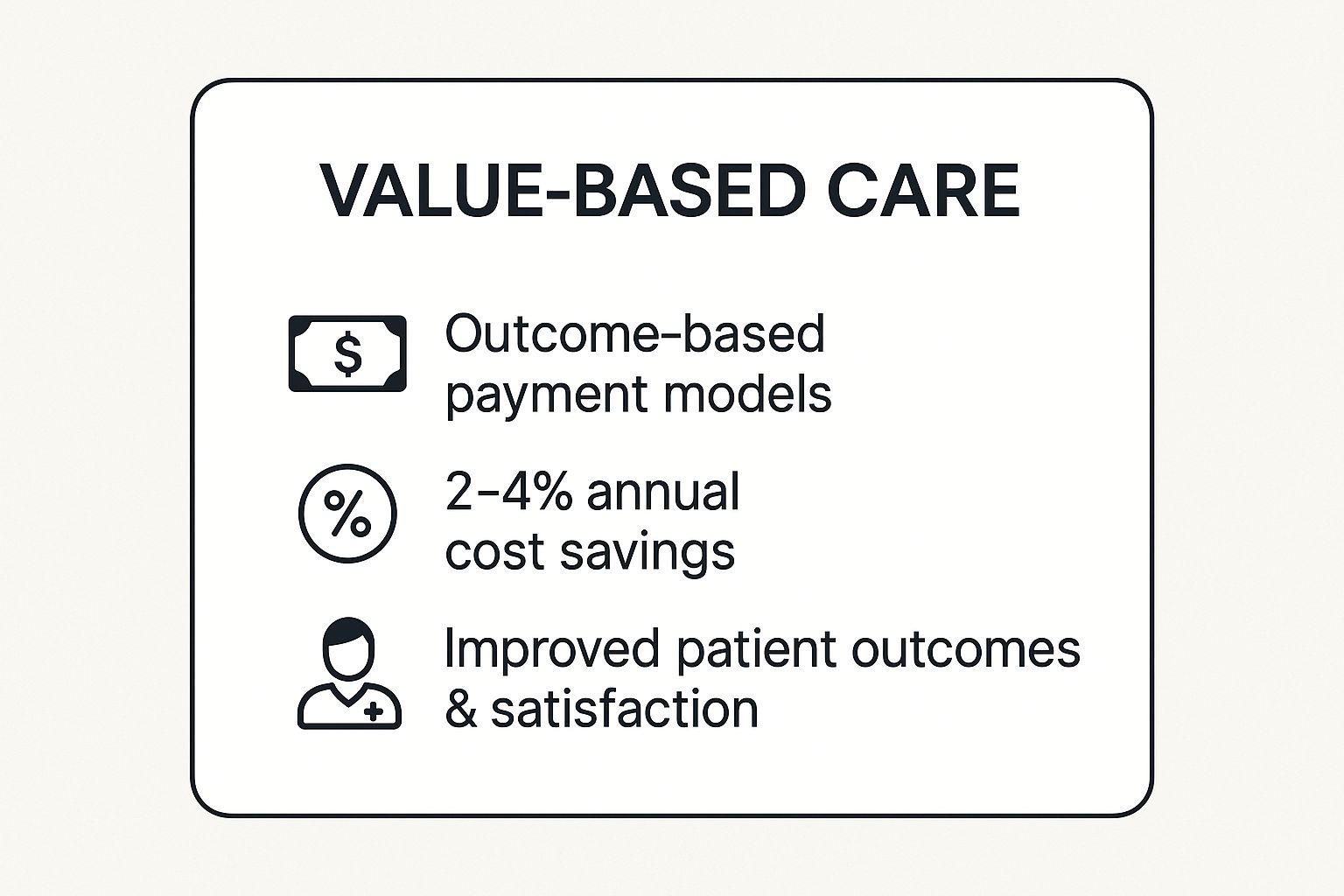The landscape of healthcare is complex and often expensive, leaving many to wonder how they can manage medical bills without compromising the quality of care. The good news is that significant savings are achievable through strategic planning and embracing innovative care models. This is especially true in areas like wound management, where delayed or improper treatment can lead to staggering costs from hospital stays and complications. By understanding and implementing proven strategies, you can take control of your medical spending.
This article provides a comprehensive roundup of 10 effective methods for reducing healthcare costs, with a special focus on rapid, accessible interventions like at-home wound care. We will move beyond generic advice to provide a clear, actionable roadmap.
You will learn about specific, proven strategies that can be applied by patients, caregivers, and providers alike. We'll explore everything from systemic changes like value-based care and bundled payments to personal finance tools like Health Savings Accounts (HSAs). Each point is designed to offer practical insights to help you navigate the system more affordably and achieve better health outcomes. This guide cuts through the complexity, delivering the essential information you need to make informed financial decisions about your health.
1. Embrace Value-Based Care for Better Outcomes
Transitioning from a fee-for-service model to value-based care is a fundamental strategy for reducing healthcare costs while simultaneously improving patient outcomes. This approach shifts the financial incentive from the quantity of services provided to the quality of results achieved. Instead of paying for each test, procedure, or visit, providers are compensated based on patient health outcomes, satisfaction, and overall cost-effectiveness. This encourages a focus on preventive care and efficient treatments, ultimately minimizing unnecessary hospitalizations and procedures.
How Value-Based Care Works
This model is successfully demonstrated by organizations like Kaiser Permanente, whose integrated care system aligns provider incentives with patient well-being, and Medicare Advantage plans, which have shown consistent annual cost savings. By prioritizing coordinated, high-quality care, these systems create a more sustainable healthcare ecosystem. For patients managing chronic wounds, this means a focus on comprehensive treatment plans that prevent complications rather than just reacting to them.
The following graphic summarizes the core components of this effective model.

As the data highlights, the benefits of this system are clear: it creates significant cost savings while boosting patient health and satisfaction. For those seeking to lower their medical expenses, supporting and choosing providers who operate within a value-based framework is a powerful and proactive step.
2. Preventive Care and Wellness Programs
Investing in preventive care and wellness programs is a proactive strategy for reducing healthcare costs by addressing health issues before they escalate. This approach prioritizes keeping people healthy through routine screenings, vaccinations, and lifestyle education, rather than waiting to treat sickness. By preventing chronic diseases or catching them in early, more manageable stages, these programs significantly lower the need for expensive emergency visits, complex procedures, and long-term specialized care.
How Preventive Care Works
This model’s effectiveness is proven by major corporations and health systems. For instance, Johnson & Johnson’s employee wellness program saved the company $250 million over six years, yielding a return of $2.71 for every dollar spent. Similarly, Medicare’s Annual Wellness Visit encourages beneficiaries to develop personalized prevention plans with their providers. For patients, particularly those managing or at risk for conditions like diabetic foot ulcers, engaging in preventive screenings and lifestyle changes can avert severe complications and costly hospitalizations.
The following graphic summarizes the core components of this effective model.
As the data shows, the benefits are substantial. Focusing on prevention not only leads to better health outcomes but also creates a more affordable and sustainable healthcare system. For individuals looking to control medical expenses, actively participating in available wellness programs and scheduling routine check-ups is a smart and impactful choice.
3. Telemedicine and Digital Health
Leveraging telemedicine and digital health tools is a powerful strategy for reducing healthcare costs by making medical services more accessible and efficient. This approach uses digital communication technologies, such as video consultations, remote patient monitoring, and mobile health apps, to deliver care remotely. By minimizing the need for in-person visits, it reduces travel time and expenses, lowers overhead for providers, and allows for more timely interventions, which is especially critical for managing conditions like chronic wounds where early detection of issues can prevent costly complications.

How Telemedicine and Digital Health Work
This model’s effectiveness is evident across the industry. For instance, Teladoc Health reports not only significant cost savings but also high patient satisfaction. Similarly, the Department of Veterans Affairs has successfully expanded its telehealth program to serve over two million veterans, improving access to care while managing expenses. These platforms connect patients with specialists quickly, facilitate routine follow-ups without the logistical burden of an office visit, and empower individuals to take a more active role in their health management through accessible digital tools.
The following video explains how telemedicine is transforming healthcare delivery.
As these examples show, integrating digital health is a practical step toward a more affordable and responsive healthcare system. For patients, particularly those with mobility issues or in remote areas, it offers a convenient and effective way to receive consistent, high-quality care, ultimately leading to better outcomes and lower overall medical bills.
4. Price Transparency Initiatives
Empowering patients with clear pricing information is a critical step toward reducing healthcare costs. Price transparency initiatives aim to make the costs of medical services, procedures, and treatments readily available to consumers before they receive care. This approach dismantles the traditional opacity of healthcare billing, allowing patients to make informed decisions based on both cost and quality. When providers compete on price, it drives down costs across the system and encourages efficiency, creating a more consumer-friendly market.
How Price Transparency Works
This model is gaining traction through federal mandates and pioneering providers. The CMS Hospital Price Transparency Rule, enacted in 2021, requires hospitals to publish their standard charges. Similarly, institutions like the Surgery Center of Oklahoma and major retailers like Walmart have built their models on providing clear, upfront pricing for common procedures. For patients needing wound care supplies or debridement services, this means they can compare costs between different facilities or providers, avoiding unexpectedly high bills and choosing the most cost-effective option for their treatment plan.
By providing easy-to-use cost estimation tools and pairing price data with quality metrics, these initiatives give patients unprecedented control. For anyone looking to actively manage their medical expenses, seeking out and utilizing these transparent pricing resources is a powerful strategy. It shifts the power dynamic, enabling you to become an active, informed participant in your healthcare journey.
5. Pharmaceutical Cost Management
Implementing effective pharmaceutical cost management is a critical strategy for reducing healthcare costs, as prescription drugs represent a significant and growing portion of medical spending. This approach involves a multi-pronged effort to control expenses through generic substitution, smart formulary management, and leveraging pharmacy benefit managers (PBMs). The goal is to ensure patients receive necessary medications affordably without compromising care quality, which is especially vital for those managing chronic conditions requiring long-term prescriptions.

How Pharmaceutical Management Works
This strategy is successfully implemented by various players in the healthcare industry. For instance, Walmart's $4 generic prescription program offers hundreds of common medications at a low, fixed price, making treatment accessible. Similarly, PBMs like CVS Caremark and Express Scripts negotiate lower drug prices with manufacturers and use formulary management to guide patients and providers toward the most cost-effective options, often saving 15-20%. On the patient side, platforms like GoodRx and Mark Cuban Cost Plus Drug Company provide price transparency and deep discounts, empowering consumers to find the best deals.
For patients and providers, proactive management is key. This means:
- Promoting Generic Alternatives: Always ask if a clinically appropriate, lower-cost generic is available.
- Using Discount Programs: Leverage resources like GoodRx or manufacturer coupons to lower out-of-pocket expenses.
- Understanding Formularies: Review your insurance plan's formulary to select covered, cost-effective medications.
By actively managing prescription choices and costs, both individuals and the healthcare system can achieve substantial savings. This makes essential treatments, like antibiotics for wound infections or long-term medications, more sustainable and affordable.
6. Care Coordination and Integrated Delivery
Implementing care coordination and an integrated delivery model is a proven strategy for reducing healthcare costs by ensuring all providers involved in a patient's treatment are working together. This systematic approach organizes patient care activities and facilitates information sharing among all participants. This cohesion reduces duplicate tests, prevents medical errors, and provides seamless continuity of care as patients move between different settings, such as from a hospital to a home care environment.
How Care Coordination Works
This model is exemplified by institutions like Intermountain Healthcare and Kaiser Permanente, which have built integrated delivery systems that align all aspects of patient care. In these systems, specialists, primary care physicians, and other caregivers use shared electronic health records and clear communication protocols. For a patient with a chronic wound, this means their dermatologist, primary doctor, and home health nurse are all on the same page, preventing conflicting treatments and ensuring consistent, effective care.
By creating standardized care pathways and using dedicated care coordinators for complex cases, these systems eliminate inefficiencies and improve patient safety. This integrated approach ensures treatments are not only effective but also delivered in the most cost-efficient manner, avoiding the high expenses associated with fragmented, reactive healthcare.
7. Artificial Intelligence and Data Analytics
Harnessing artificial intelligence (AI) and advanced data analytics is a powerful strategy for reducing healthcare costs by transforming raw data into actionable insights. This technological approach allows providers to predict health risks, optimize treatment plans, and streamline operations with unprecedented accuracy. By analyzing vast datasets, AI can identify patterns and inefficiencies that are invisible to the human eye, leading to more precise diagnostics, personalized patient care, and a significant reduction in administrative waste.
How AI and Data Analytics Work
Leading health systems are already demonstrating the impact of this technology. For instance, predictive models can flag patients at high risk for readmission, allowing care teams to intervene proactively. AI-powered tools assist radiologists in detecting diseases like cancer earlier and more accurately, while machine learning algorithms optimize hospital workflows and supply chain management. For a patient managing a complex wound, this could mean an AI-driven tool that analyzes wound images to predict healing trajectories and recommend the most effective treatment protocol, preventing costly complications.
The following graphic summarizes the core components of this effective model.
As the data shows, integrating AI and analytics augments clinical decision-making and enhances operational efficiency. For healthcare organizations and patients alike, embracing these tools is a crucial step toward creating a more affordable, proactive, and effective healthcare system.
8. Adopt Bundled Payment Models
Adopting bundled payment models offers a powerful strategy for reducing healthcare costs by consolidating payments for an entire episode of care. Instead of billing separately for each service, providers receive a single, pre-determined payment for all care related to a specific treatment or condition, such as a joint replacement or cardiac surgery. This model incentivizes efficiency and collaboration among all providers involved, from surgeons to physical therapists, as they share financial accountability for the patient's outcome over a defined period.
How Bundled Payments Work
This approach encourages providers to eliminate redundant tests and services, improve care coordination, and focus on delivering high-quality, cost-effective treatment. For instance, Medicare’s Bundled Payments for Care Improvement (BPCI) initiative and Geisinger Health System's ProvenCare program for cardiac procedures have demonstrated significant cost reductions while maintaining or even improving patient outcomes. In wound care, this means coordinating all aspects of treatment, from initial debridement to follow-up home care, under one financial umbrella to prevent costly complications and re-hospitalizations.
To successfully implement this model, healthcare organizations should:
- Start with well-defined, predictable procedures like joint replacements.
- Establish clear care pathways and evidence-based protocols.
- Invest in robust care coordination to manage the patient journey seamlessly.
- Engage all providers in the episode of care to align goals and responsibilities.
By bundling payments, the system shifts focus from volume to value, ensuring that every part of the care process is optimized for both patient health and financial sustainability.
9. Opt for Ambulatory Surgery Centers (ASCs)
Choosing an Ambulatory Surgery Center (ASC) for outpatient procedures is a highly effective strategy for reducing healthcare costs without compromising on quality. ASCs are specialized healthcare facilities providing surgical services that do not require an overnight hospital stay. By focusing on specific types of procedures, these centers operate with greater efficiency, lower overhead, and more predictable scheduling than traditional hospitals. This streamlined approach translates directly into significant cost savings for both patients and insurers.
How ASCs Reduce Expenses
ASCs achieve cost-effectiveness by specializing in high-volume, routine procedures and implementing standardized clinical protocols. This focus ensures consistent, high-quality outcomes and patient safety. For example, a patient needing a debridement procedure for a non-healing wound can often have it performed in an ASC at a fraction of the cost of a hospital operating room. Organizations like Surgery Partners, which operates over 180 ASCs, and HCA Healthcare’s Surgery Care Affiliates have perfected this model, demonstrating its financial and clinical benefits.
To leverage this option, consider the following:
- Discuss with your provider: Ask if your required procedure can be safely performed in an ASC.
- Verify insurance coverage: Confirm your insurance plan includes local ASCs in its network.
- Compare costs: Request cost estimates from both the hospital and an ASC to see the potential savings.
By selecting an ASC for appropriate surgical needs, patients can access convenient, high-quality care while substantially lowering their out-of-pocket expenses, making it a smart choice for managing medical bills.
10. Health Savings Accounts (HSAs) and Consumer-Directed Healthcare
Pairing a Health Savings Account (HSA) with a high-deductible health plan (HDHP) is a powerful consumer-directed strategy for reducing healthcare costs. This approach gives you more control over your healthcare spending by allowing you to save pre-tax money for medical expenses. The funds grow tax-free and can be withdrawn tax-free for qualified medical costs, creating a unique triple-tax advantage. This financial structure incentivizes you to become a more conscious healthcare consumer, encouraging you to shop for value and make informed decisions about your care.
How HSAs Empower Consumers
This model is successfully used across various sectors. The federal government offers robust HSA options to its employees, while large corporations like Walmart provide HSAs to millions of associates, promoting cost-conscious healthcare choices. These accounts are not just for immediate expenses; they can also serve as a long-term investment vehicle for future medical needs. For patients managing ongoing conditions like chronic wounds, an HSA provides a dedicated, tax-advantaged fund to cover costs for specialized dressings, treatments, and telehealth consultations not always fully covered by insurance.
To maximize the benefits of an HSA, it's crucial to understand how to use it effectively.
- Prioritize preventive care: Many HDHPs cover preventive services before the deductible is met.
- Use price transparency tools: Shop around for procedures and prescriptions to find the best value.
- Contribute consistently: Treat your HSA as a long-term savings tool, not just a short-term spending account.
By actively managing an HSA, you can take direct control of your medical budget, ensuring funds are available when needed while minimizing your overall tax burden and healthcare expenditures.
Cost Reduction Strategies: 10-Point Comparison
| Item | Implementation Complexity 🔄 | Resource Requirements ⚡ | Expected Outcomes 📊 | Ideal Use Cases 💡 | Key Advantages ⭐ |
|---|---|---|---|---|---|
| Value-Based Care | High – 3-5 years, complex measurement | Significant investment in data & analytics | Reduced costs (2-4%), improved outcomes | Chronic disease management, coordinated care | Aligns incentives with patient health, reduces unnecessary care |
| Preventive Care and Wellness | Moderate – sustained engagement needed | High upfront, ongoing program support | Long-term cost savings (3-6:1 ROI), better population health | Disease prevention, lifestyle modification, workplace wellness | Early detection, reduces ER visits, improves productivity |
| Telemedicine and Digital Health | Moderate – technology and training required | Investment in digital platforms | Cost reduction (20-30%), improved access | Remote/rural care, routine consultations, continuous monitoring | Increases convenience, reduces travel and readmissions |
| Price Transparency Initiatives | Moderate to High – requires administrative setup | Data management and IT systems | Improved market efficiency, reduces surprise billing | Consumer decision support, price shopping | Empowers patients, promotes competition, builds trust |
| Pharmaceutical Cost Management | Moderate – ongoing management effort | Pharmacy benefit management infrastructure | Significant drug cost reduction (80-85%) | Medication cost control, formulary management | Reduces prescription costs, improves adherence |
| Care Coordination and Integrated Delivery | High – cultural change, organizational complexity | Investment in EHRs and coordination teams | Cost reduction (15-20%), better outcomes | Complex patients, multi-provider settings | Prevents duplication, reduces errors, improves satisfaction |
| Artificial Intelligence & Data Analytics | High – costly infrastructure and training | Advanced data systems and expertise | Potential $150B annual cost reduction | Risk prediction, diagnostic assistance, operational efficiency | Improves diagnostics, early intervention, personalized care |
| Bundled Payment Models | High – complex cost accounting and protocols | Investment in care coordination | Episode cost reduction (10-20%), predictable costs | Surgical episodes, well-defined procedures | Aligns incentives, reduces unnecessary services |
| Ambulatory Surgery Centers (ASCs) | Moderate – facility setup, protocol standardization | Specialized outpatient facility investment | 45-60% lower costs than hospital surgeries | Outpatient surgeries, routine procedures | Cost-effective, patient convenience, lower infection rates |
| Health Savings Accounts (HSAs) & Consumer-Directed Healthcare | Moderate – education and engagement required | Administrative and educational resources | Premium reduction (20-30%), increased consumer cost-awareness | High-deductible plans, consumer-driven decisions | Tax advantages, long-term savings, portability |
Your Blueprint for Affordable, High-Quality Care
Navigating the complexities of the healthcare system can feel overwhelming, but as this guide has demonstrated, you are far from powerless. The journey toward reducing healthcare costs is not about sacrificing quality or forgoing necessary treatments. Instead, it is about making a fundamental shift in perspective, transforming from a passive recipient of care to an active, informed, and empowered architect of your own health journey. By embracing the strategies outlined, you are not just trimming expenses; you are investing in a more efficient, effective, and ultimately healthier future.
The ten strategies we have explored, from leveraging Health Savings Accounts (HSAs) to embracing value-based care models, collectively form a powerful blueprint for financial wellness. Each represents a significant opportunity to take control. You can proactively manage chronic conditions through preventive care and wellness programs, access convenient and cost-effective consultations via telemedicine, and demand clarity with price transparency tools. These are not abstract concepts but tangible actions that yield real-world savings and improved outcomes.
From Reactive to Proactive: The Core Takeaway
The most critical takeaway is the immense value of proactive intervention. Waiting for a health issue to escalate into an emergency is often the most expensive path. This is especially true for conditions like chronic or acute wounds, where early and expert care can prevent a cascade of costly complications, from infections and emergency room visits to prolonged hospital stays.
Consider the powerful intersection of several strategies discussed:
- Telemedicine and Digital Health: Enables immediate consultation with a specialist without the barriers of travel or long wait times.
- Care Coordination: Ensures your primary care provider and specialists are working together, preventing redundant tests and treatments.
- Value-Based Care: Focuses on the outcome of your treatment, rewarding providers for keeping you healthy and out of the hospital.
This proactive, coordinated, and value-driven approach is the cornerstone of modern, affordable healthcare. It’s about getting the right care, at the right time, in the right setting. Making informed choices, such as utilizing an Ambulatory Surgery Center (ASC) for a minor procedure or managing prescriptions wisely, compounds these benefits over time, leading to substantial long-term savings.
Your Next Steps to Lower Healthcare Expenses
Embarking on this path doesn't require a complete overhaul overnight. Start with small, manageable steps. Review your current insurance plan to fully understand its benefits, especially for preventive services and telemedicine. If you have a high-deductible plan, investigate opening an HSA. The next time you need a prescription, use a price comparison tool. By consistently applying these principles, you build momentum, creating a sustainable habit of smart healthcare consumption. This proactive mindset is your greatest asset in reducing healthcare costs while enhancing your overall well-being.
Ready to see how specialized, at-home care can drastically lower your medical bills and improve healing? Discover how Rapid Wound Care brings expert wound treatment directly to your door, preventing costly hospitalizations and promoting faster recovery. Visit Rapid Wound Care to learn how our model aligns with the cost-saving principles you've just learned about.

